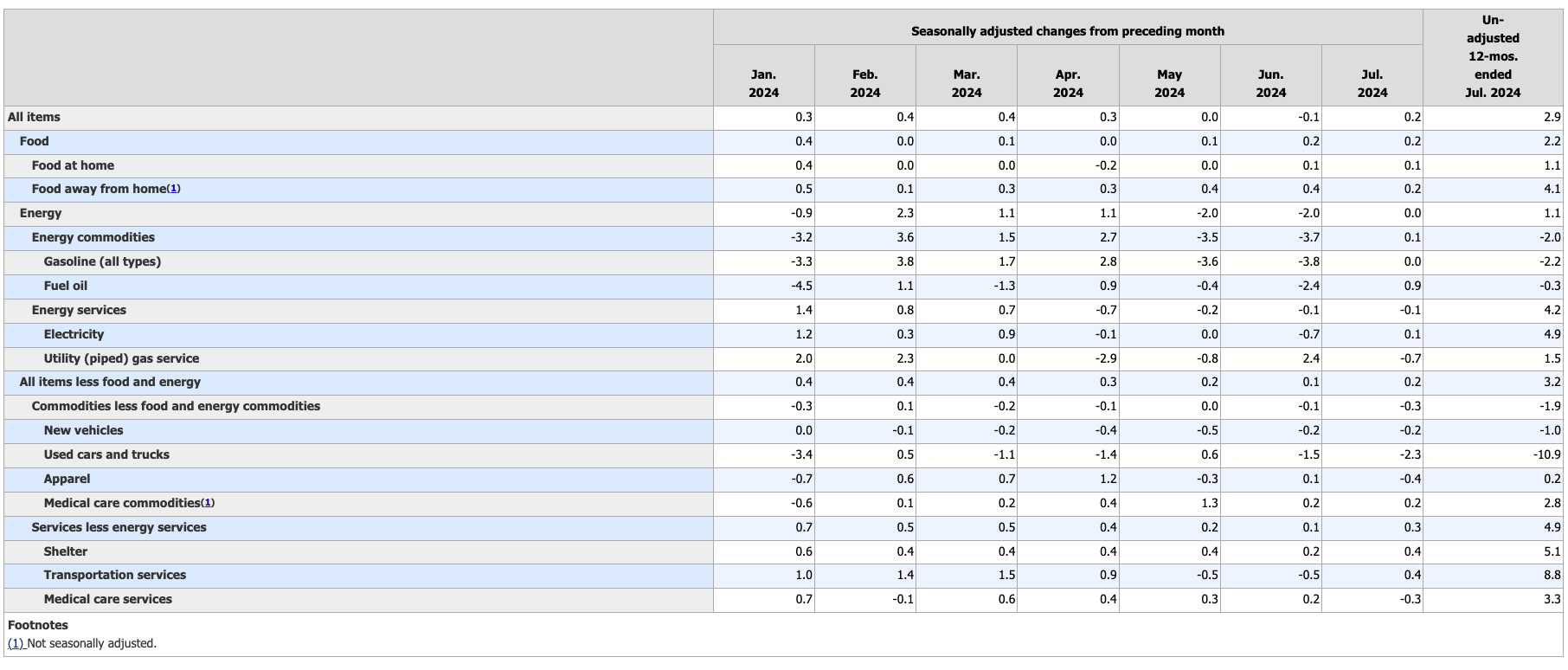Don’t be fooled when you hear “inflation is coming down.” That's not the plan and it never was.
The fact is price inflation was up in July.
And it will be up in August.
And it will be up in September.
That’s because rising price inflation is the Federal Reserve’s stated policy.
Remember, the target is 2 percent annual price inflation. That means the plan is for prices to generally rise by 0.16 percent every month.
And they’re not even there yet.
Breaking down the July CPI
Prices rose 0.2 percent in July, having contracted by 0.1 percent in June, according to the latest data from the BLS. That dropped the annual CPI under 3 percent (2.9%) for the first time since March 2021.
Stripping out more volatile food and energy prices, core CPI increased by 0.2 percent dropping the annual core CPI to 3.2 percent.
You will note that none of these numbers actually is 2 percent.
You should also note that price inflation is worse than the government data suggest. The government revised the CPI formula in the 1990s so that it understates the actual rise in prices. Based on the formula used in the 1970s, CPI is closer to double the official numbers. So, if the BLS was using the old formula, we’re looking at CPI closer to 6 percent. And using an honest formula, it would probably be worse than that.
Digging deeper into the numbers, shelter costs continue to drive the total CPI higher. The shelter index was up 0.4 percent month-on-month. The energy index was unchanged over the month, after declining in the two
preceding months. The index for food increased 0.2 percent in July, as it did in June. The food away from home index rose 0.2 percent over the month, and the food at home index increased 0.1 percent.
We’re seeing deflation in new and used vehicles as tapped-out consumers slow spending on big-ticket items.
Further CPI cooling increased optimism for a September interest rate cut. The mainstream consensus seems to be that the Fed is now locked and loaded. As one analyst told CNBC, “Today’s CPI print removes any lingering inflation obstacles that may have been preventing the Fed from starting the rate-cutting cycle in September.”
In other words, the Fed has reined in price inflation enough to plausibly resume its inflationary policies.
And make no mistake, inflation is the policy.
What’s magical about two percent?
Have you ever wondered why 2 percent is the price inflation target?
Because they made it up.
That’s the honest answer.
They pulled 2 percent out of thin air and anointed it the “perfect” amount of price inflation.
That’s it. There’s no science. There’s no formula proving that 2 percent is the Goldilocks of inflation rates. There's no proof of any kind. People just said "2 percent" long enough and loud enough to make it “true.”
But think about what this actually means. The stated policy is to devalue the currency by 2 percent every year. That means you lose 10 percent of your purchasing power every five years and 20 percent each decade.
It sounds less benign when you put it that way, doesn’t it?
And that’s the point.
The government wants inflation but it doesn't want you to notice.
You see, the government needs inflation. It needs to be able to expand the money supply in order to maintain its borrowing and spending habits. It needs the central bank to create money out of thin air and monetize the debt. Easy money is the fuel that powers big government, and easy money means price inflation.
This is precisely why FDR and Richard Nixon severed the dollar from the gold standard. The government couldn’t fund its wars and welfare with sound money.
So, the government constantly walks a tightrope. It wants as much inflation as it can get, but it doesn’t want you to notice.
That was the real problem with the price inflation after the unprecedented monetary stimulus during the pandemic – you noticed.
They tried desperately to keep you from noticing. They insisted inflation was transitory. But when they could no longer pedal that lie, they were forced to raise rates to get the inflation dragon under control. But don’t think for one second that they want to kill it. They need the inflation dragon alive but collared.
The problem is that controlling a dragon is easier said than done.
Money Metals Exchange and its staff do not act as personal investment advisors for any specific individual. Nor do we advocate the purchase or sale of any regulated security listed on any exchange for any specific individual. Readers and customers should be aware that, although our track record is excellent, investment markets have inherent risks and there can be no guarantee of future profits. Likewise, our past performance does not assure the same future. You are responsible for your investment decisions, and they should be made in consultation with your own advisors. By purchasing through Money Metals, you understand our company not responsible for any losses caused by your investment decisions, nor do we have any claim to any market gains you may enjoy. This Website is provided “as is,” and Money Metals disclaims all warranties (express or implied) and any and all responsibility or liability for the accuracy, legality, reliability, or availability of any content on the Website.
Recommended Content
Editors’ Picks
EUR/USD pulls away from daily lows, stays below 1.1000

EUR/USD stages a modest rebound from the daily low it set at 1.0950 on upbeat US data releases but remains below 1.1000 in the American session. The improving risk mood limits the US Dollar's gains and helps the pair find support.
GBP/USD rebounds to 1.2850 on improving risk mood

GBP/USD regains its traction and trades marginally higher on the day near 1.2850. Although the pair came under bearish pressure after strong US data releases, it managed to reverse its direction with risk flows starting to dominate the action in financial markets.
Gold climbs above $2,450 despite rising US yields

Gold trades in positive territory above $2,450 in the American session on Thursday after dropping toward $2,430 with the immediate reaction to the stronger-than-forecast US data. The benchmark 10-year US yield is up more than 2% on the day above 3.9%, capping XAU/USD's upside.
AAVE price eyes for rally after retest of support level

Aave (AAVE) price trades slightly higher during the Asian trading session on Thursday after surging on Wednesday. On-chain data shows that open interest, daily active addresses and development activity are rising, signaling a bullish trend.
Fed rate cut in September? The data will decide

The US economy is currently navigating a period of slowing growth, persistent inflation, and a tight labour market. The Fed's aggressive monetary policy tightening over the past year has started to show results in moderating inflation
